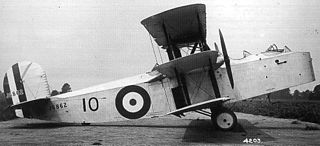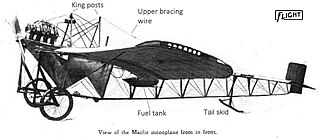
A triplane is a fixed-wing aircraft equipped with three vertically stacked wing planes. Tailplanes and canard foreplanes are not normally included in this count, although they occasionally are.

The Roe I Biplane was the first powered aircraft to be designed, built, and flown in England. Designed in an attempt to claim a prize offered by the Brooklands Automobile Racing Club, it was designed and built by Alliott Verdon Roe, who based it on a powered model with which he had won a Daily Mail prize of £75 at Alexandra Palace in April 1907. This prize was substantially larger: the club committee was offering £2,500 for the first person to fly a circuit of their three-mile (4.8 km) race track by the end of the year. In addition the Daily Graphic was offering a £1,000 prize for a flight of more than a mile (1.6 km).

The Roe III Triplane was an early aircraft designed by the British aircraft manufacturer Avro. In configuration, it was similar to the Roe II Triplane, with a triplane tailplane and an open-top fuselage of triangular cross-section, but the Roe III was a two-seater, and featured ailerons for the first time in a Roe design. The five production machines differed from the prototype in having the ailerons fitted to the middle wing and in being powered by a Green engine in place of the prototype's JAP.

The Roe IV Triplane was an early British aircraft designed by Alliott Verdon Roe and built by A.V. Roe and Company. It was first flown in September 1910.

The Avro Type D was an aircraft built in 1911 by the pioneer British aircraft designer A.V. Roe. Roe had previously built and flown several aircraft at Brooklands, most being tractor layout triplanes. The Type D was his first biplane.

The Avro Type E, Type 500, and Type 502 made up a family of early British military aircraft, regarded by Alliott Verdon Roe as his firm's first truly successful design. It was a forerunner of the Avro 504, one of the outstanding aircraft of the First World War.

The Blackburn Triplane was a single-engine pusher single-seater, designed specifically to attack Zeppelins. It flew in 1917, but was not successful.
The Avro Burga was built by Avro for R.F. Burga to test his unique system of lateral control. It was a single-engined two-seat monoplane, fitted with differentially operated surfaces above and below the central fuselage.

The Handley Page Type E was a two-seat, single-engined monoplane intended as a demonstrator. Though only one was built, it flew successfully from 1912 to 1914, carrying several hundred passengers and flying several thousand miles.

The Cranwell CLA.3 was a parasol winged single-engined, single-seat British aircraft built to compete in the Lympne air races of 1925. It was designed and built by an amateur group drawn from staff and pupils at the RAF College Cranwell. Though it won one prize and set a Class record, only one CLA.3 was made.

The Parnall Possum was an experimental triplane with a single, central engine driving wing-mounted propellers via shafts and gears. Two of these British aircraft were built in the mid-1920s.
The Blackburn Type E was a development of the earlier Blackburn Mercury single-engined monoplanes, but was innovative in its use of steel tubing to construct the fuselage. It was built during 1912 to compete in the Military Aeroplane Trials. A single-seat version flew, but the military two-seater did not.

The Macfie monoplane was a British shoulder wing, tractor monoplane. The aircraft was powered by a 35 hp (26 kW) J.A.P. V8 engine fixed at the front of an open-frame 'fuselage', at the rear end of which a tailplane and vertical rudder were mounted.
The Scottish Aeroplane Avis was a tractor monoplane built by Howard T. Wright in 1909. At that time Wright was one of England's foremost aircraft engineers, and had several monoplane aircraft under development. The Avis was shown at the 1910 Aero Exhibition in London and several examples were successfully flown during 1910.
The Howard Wright 1909 Monoplane was the first of a series of tractor configuration monoplane aircraft built by Wright in England during 1909 and 1910. A variant, the Lascelles Ornis, was displayed at the 1910 Aero Show at Olympia in London.

The Martin Handasyde No.3 was an early British single-seat monoplane design, built in partnership by H.P. Martin and George Handasyde. Only one was built.

The Hanriot 1909 monoplane was an early French aircraft constructed by Rene Hanriot, a successful automobile racer.

The 1910 Deperdussin monoplane was the first aircraft to be built in significant quantities by Aéroplanes Deperdussin. The type was produced in a number of variants which were flown successfully in air races and gained several records during 1911, and was used by the Australian Central Flying School at Point Cook, Victoria. Several have survived, including an airworthy example in the Shuttleworth Collection in England.

The Kawanishi K-6 was a passenger-carrying biplane floatplane, built in Japan in the 1920s. The sole example took part in an around Japan flight then flew as a transport with Japan Aviation.
The Itoh Emi 30 was a small, single-engined, sports biplane built in Japan in 1922. Though it attracted attention by being the smallest Japanese aircraft of its time, the sole example was mostly used as an aerobatics trainer.

















